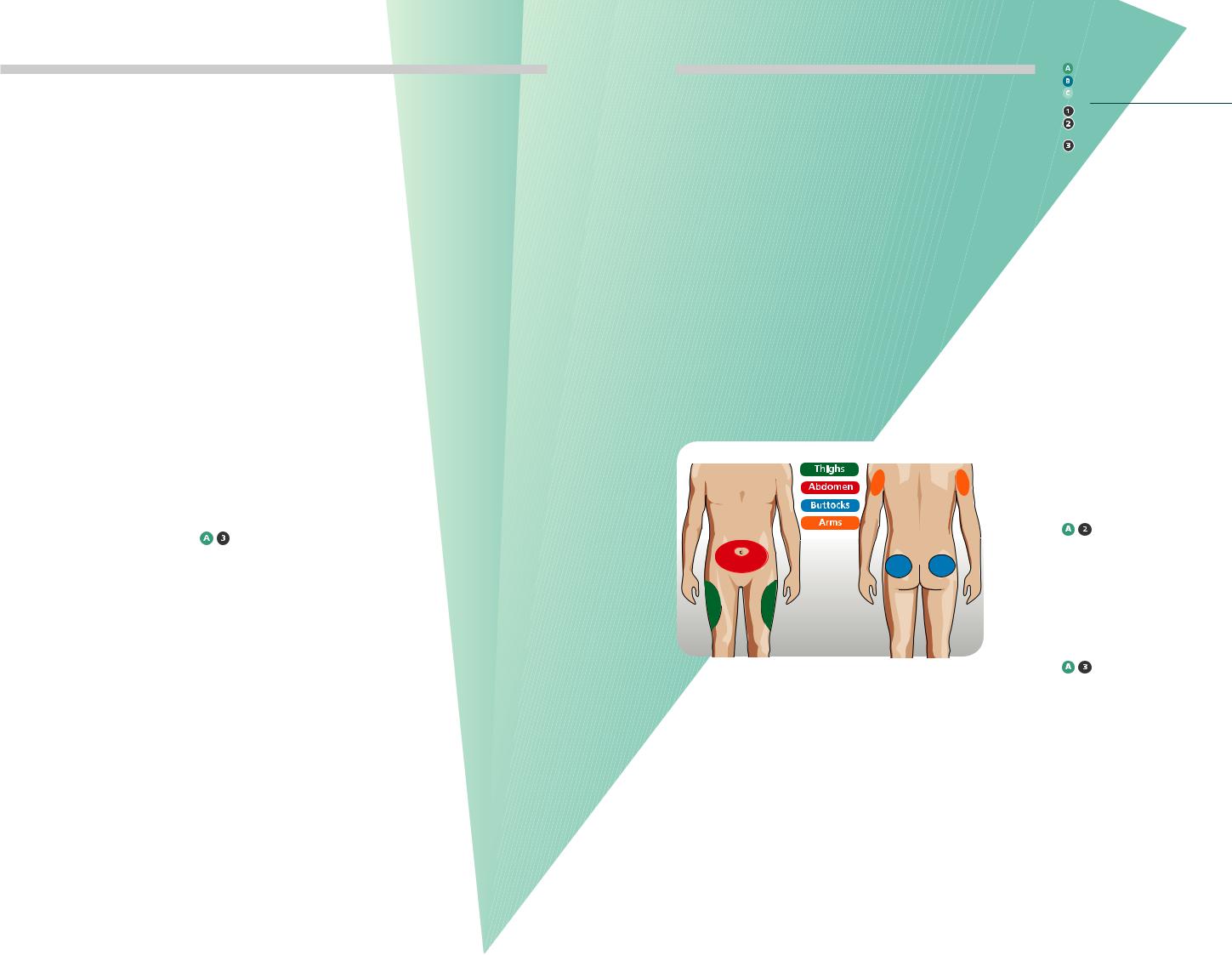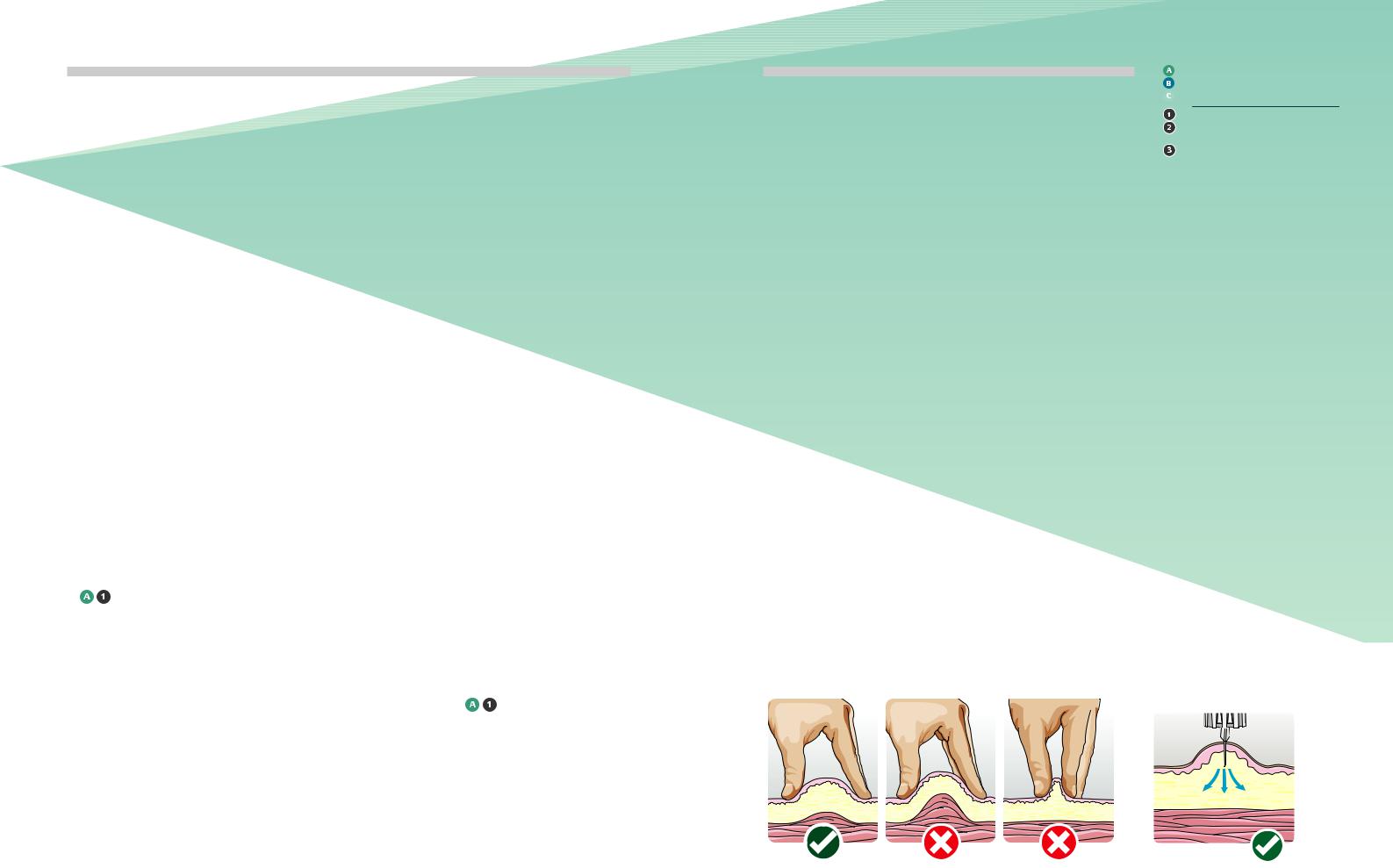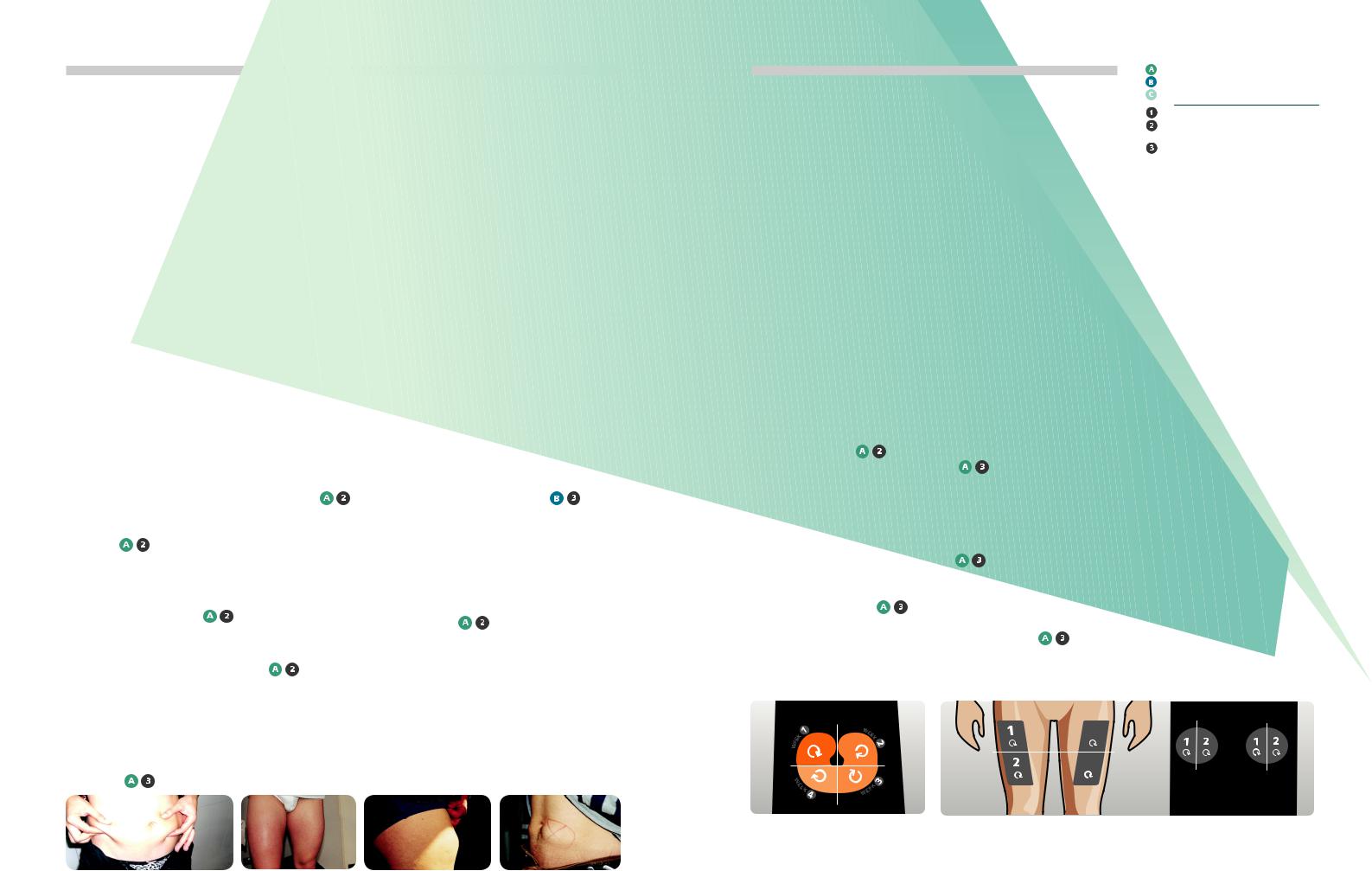
fit_brochure
.pdf
DIABETES CARE IN THE UK
The First UK
Injection Technique
Recommendations

THE FIRST INJECTION TECHNIQUE RECOMMENDATIONS
The Forum for Injection Technique (FIT) was developed to establish and promote best practice in injection technique for all involved in diabetes care and the founding members are experienced diabetes specialist nurses.
These recommendations aim to raise awareness of existing and emerging research relating to injection technique and the impact this may have on health outcomes for those with diabetes that require subcutaneous injection therapy.
FIT was established following the 3rd International Injection
Technique meeting (Athens 2009). From this meeting a consensus was reached to establish the international injection technique recommendations. Following
a very successful inaugural symposium held in London on 4th June 2010, attended by over 40 experienced diabetes specialist nurses from across the United Kingdom (UK) and Ireland, the international injection technique recommendations have been adapted for use in the UK.
These are the first UK recommendations for Injection Technique and these will be revised on an annual basis to include new research evidence as it emerges.
FIT is an autonomous organisation whose overarching mission is to support people with diabetes using injectable therapies to achieve the best possible health outcomes that can be influenced by correct injection technique. There are now nearly 3 million people in
the UK with diabetes and of these approximately 800,000 are on injectable therapies.*
The development of FIT and the subsequent UK recommendations for injection technique have been supported by BD Europe and endorsed by the pharmaceutical companies whose therapies include subcutaneous injections of insulin and GLP-1 agonists.
FIT is committed to supporting the implementation of the recommendations by all those involved in diabetes care and to developing the recommendations further. We welcome any comments, suggestions and active participation in ensuring that the recommendations remain relevant and useful for now and the future.
Debbie Hicks
Nurse Consultant – Diabetes (Chair)
Sheila Burmiston
Diabetes Nurse Specialist (Former Co-Chair)
Mani Basi
Nurse Consultant – Diabetes
Fiona Kirkland
Nurse Consultant – Diabetes
Julia Pledger
Nurse Consultant – Diabetes
DATE PUBLISHED: OCTOBER 2010
* data on file
KEY
A Scientific Advisory Board (Athens 2009) lead the review of available evidence and decided that for the strength of a recommendation the following scale would be used:
ASTRONGLY RECOMMENDED
BRECOMMENDED
C UNRESOLVED ISSUE
For the scientific support the following scale was used.
1 At least one randomised controlled study
2At least one non-randomised (or non-controlled or epidemiologic) study
3Consensus expert opinion based on extensive patient experience.
Thus each recommendation is followed by both
a letter and number (i.e. A2). The letter indicates the weight a recommendation should have in daily practice and the number, its degree of support in the medical literature. The most relevant publications bearing on
a recommendation are also cited. There are comparably few randomised clinical trials in the field of injection technique (compared, for example, with blood pressure control) so judgements such as ‘strongly recommended’ versus ‘recommended’ are based on a combination of the weight of clinical evidence, the implications for patient therapy and the judgement of the group
of experts.
These recommendations apply to the majority of people with diabetes using injectable therapy, but there will inevitably be individual exceptions for which these rules must be adjusted.
The New Injection Recommendations for Patients with Diabetes: Diabetes & Metabolism 2010. Vol 36. informed these recommendations and we thank the editors of Diabetes & Metabolism for permission to use material from this article.

Supported by medical technology company Becton, Dickinson U.K. Limited. (www.bddiabetes.co.uk) BD and BD Logo are trademarks of Becton, Dickinson and Company. ©2010 BD
“Diabetes UK both welcomes and supports the FIT initiative. Good injection technique leads to good blood glucose control which is vital in preventing the long term complications of diabetes. As so
many people with diabetes are now being prescribed injectable medication, this is a timely and important enterprise which”will bring great benefit to them.
SIMON O’NEILL, DIRECTOR OF CARE, INFORMATION AND ADVOCACY. DIABETES UK
“Advances in the treatment of diabetes have led to an increase in the number of injectable therapies available. Correct technique is of paramount importance in order to ensure the benefits of injectable therapies such as insulin and GLP-1s. The Forum for Injectable Therapy (FIT) provides comprehensive evidenced based guidelines to improve the process and education of self injection technique for people with diabetes. As a company committed to
improving the care of patients with diabetes, Lilly UK welcomes the FIT initiative as an important step in supporting diabetes”care in the United Kingdom.
IAN DANE, SENIOR DIRECTOR, ELI LILLY & COMPANY
“Novo Nordisk fully endorse the FIT initiative. The benefits of modern injectable medications for the treatment of diabetes can only be fully realised through the use of correct injection technique. Novo Nordisk believe it is imperative that Healthcare Professionals understand the importance of good injection
technique and convey this to people with diabetes under their care. FIT is a superb initiative, from leading professionals in the” diabetes care, which will make a big difference in this area.
JOHN DAWBER, MARKETING DIRECTOR, NOVO NORDISK LTD.
“sanofi-aventis are a company who strive to improve the care for people with diabetes who are using insulin therapy by producing a range of insulins. We are proud to support the FIT (Forum for Injection Technique) initiative which is aiming to improve current practice through demonstration of best practice and the sharing of scientific evidence. We, too, appreciate the importance of good injection technique in ensuring people with diabetes who
are using insulin therapy achieve the most benefit from their medication and wish FIT every success. We look forward to” working with FIT in the future”.
JASON BROWN, DIABETES BRAND LEAD, SANOFI-AVENTIS
STRONGLY RECOMMENDED
RECOMMENDED
UNRESOLVED ISSUE
At least one randomised controlled study
At least one non-randomised
(or non-controlled or epidemiologic) study
Consensus expert opinion based on extensive patient experience.
1.0
Psychological Challenges of Injections
1.1 Children |
1.2 Adults |
|
|
1 Children have a lower threshold |
1 The HCP should prepare all |
4 HCPs should reflect on their own |
|
for pain than adults and |
people with type 2 diabetes for |
perceptions of injectable therapy |
|
sometimes find injecting |
likely future injectable therapy |
and avoid using any terms which |
|
uncomfortable. The Healthcare |
early in the disease pathway, |
imply that such therapy is a sign |
|
Professional (HCP) should ask |
by explaining the natural, |
of failure, a form of |
|
about pain, since many young |
progressive nature of the |
or a threat. (33,34) |
|
people with diabetes will not |
disease, stating that it includes |
|
|
bring it |
spontaneously. |
injectable therapy and making |
5 Pen devices may have |
(18, |
|
clear that injectable therapy |
psychological advantages over |
|
|
treatment is not a |
syringes and therefore maybe |
2 Younger children may be |
of patient failure. |
more |
|
helped by distraction techniques |
|
(31,35- |
|
(as long as they do not involve |
2 Both the short-term and |
|
|
trickery) or play therapy |
long-term advantages of good |
|
|
(e.g. injecting into a stuffed |
glucose management should |
|
|
animal) while older children |
be emphasised. Finding the |
|
|
may respond better to Cognitive |
right combination of therapies |
|
|
Behavioural Therapies |
including injectables leading |
|
|
where available. |
to good glucose management |
|
|
|
|
be the goal. (31,32) |
|
3CBT includes relaxation training, guided imagery, graded
exposure, active behavioural |
3 Through culturally-appropriate |
rehearsal, modelling and |
pictures and stories, HCPs should |
reinforcement as well as |
show how injectable therapy |
incentive scheduling. |
could enhance both |
|
and quality of life. |

THE FIRST INJECTION TECHNIQUE RECOMMENDATIONS
2.0
Therapeutic Education
Adult
1The HCP should spend time exploring the individual’s anxieties about the injecting process and the injectable therapy itself. (33,40) 

2At the beginning of injection therapy (and at least every year thereafter) the HCP should discuss:
•Injecting regimen
•Choice and management of the devices used
•Choice, care and self-examination of injection sites
•Correct injection techniques (including site rotation, injection angle and possible use of
skin folds)
•Injection complications and how to avoid them
•Optimal needle length
•Safe disposal of used sharps (32-35, 38-41)
Ensure that each of these topics have been fully understood. (34) 

3Injection technique education should be put in place and regularly reviewed and recorded in the individuals care plan.
4Current injection practice should be discussed and if possible observed. Injection sites should be examined and palpated, if possible at each visit but at least once a year. (38,40,41) 

3.0
Injection Sites
The diagram shows the current recommended injection sites for injectable therapy
Figure 1:
Recommended injection sites.
STRONGLY RECOMMENDED
RECOMMENDED
UNRESOLVED ISSUE
At least one randomised controlled study
At least one non-randomised
(or non-controlled or epidemiologic) study
Consensus expert opinion based on extensive patient experience.
4.0
Injection Site Care
1The site should be inspected and palpated by the individual prior to injection. (5,6) 

2Avoid using a site showing signs of lipohypertrophy, inflammation, oedema or infection until the problem has been resolved. (15,49,50 – 55)
3Injections should be given into a clean site using clean hands. (56) 

4The site should be cleansed with soap and water when found to be unclean. (56)
5Disinfection of the site is usually not required; however,
alcohol swabs may be used prior to injections given in the hospital or care home setting.
(6, 57-60) 


THE FIRST INJECTION TECHNIQUE RECOMMENDATIONS
5.0 |
6.0 |
Insulin Storage |
Injecting Process |
and Suspension |
|
1Store injectable medication in current use at room temperature (for a maximum of one month after initial use, and within expiry date). Avoid direct sunlight and areas of temperature extremes. Store
unopened injectable medication in an area of the refrigerator where freezing is unlikely
to occur. (66,67) 

2Cloudy insulin (e.g. NPH and pre-mixed insulin) must be gently rolled ten times and inverted ten times (not shaken) until the crystals go back into suspension and the solution becomes milky white.
(61-65) 

Tips for making injections less painful include:
•Keeping injectable therapy in use, at room temperature (66,67) 

•Using needles of shorter length and smaller diameter (157)
•Using a new needle at each injection (5,6,17,36,68) 

•Insert the needle in a quick smooth movement through the skin (69) 

•Inject slowly and ensure that the plunger (syringe) or thumb button (pen) has been fully depressed (69) 

•If using alcohol swabs, inject only when the alcohol has fully dried 

STRONGLY RECOMMENDED
RECOMMENDED
UNRESOLVED ISSUE
At least one randomised controlled study
At least one non-randomised
(or non-controlled or epidemiologic) study
Consensus expert opinion based on extensive patient experience.
7.0 |
8.0 |
The Correct Use |
The Correct |
of Pen Devices |
Use of Syringes |
1Pen devices should be primed (observing at least a drop at the needle tip) according to the manufacturer’s instructions before each injection. Once flow is verified, the desired dose should be dialled and the injection administered. (36,68)
2Pen devices and cartridges are for single person use only and should never be shared due to the risk of cross contamination. (37,57) 

3Pen needles should be used only once. (3,5,6,17,59,76,77)
4Using a new needle each time may reduce the risk of needle breakage in the skin, ‘clogging’ of the needle, inaccurate dosing and indirect costs (e.g Abscess). (77) 

5After pushing the thumb button in completely, the individual should count slowly for 10 seconds before withdrawing the needle in order to deliver the full dose and prevent
the leakage of medication. Counting past 10 seconds may be necessary for higher doses. (61,69,71,74,78,79) 

6Needles should be safely disposed of immediately after use and not left attached to the pen. This prevents the entry of air (or other contaminants) into the cartridge as well as the leakage of medication out of the cartridge, which can
affect subsequent dose accuracy. (71-75) 

7Injecting through clothing should be discouraged. As needle lengths are becoming shorter there is increased risk of intradermal injection. 

1A syringe should be used only once and disposed of safely. (3,5,6,17,59,76,77) 

2When drawing up insulin, the air equivalent to the dose should be drawn up first and injected into the vial to facilitate easier withdrawal. 

3If air bubbles are seen in
the syringe, hold syringe with needle uppermost, tap the barrel to bring them to the top and then remove the bubbles by pushing the plunger to expel the air. 


THE FIRST INJECTION TECHNIQUE RECOMMENDATIONS
STRONGLY RECOMMENDED
RECOMMENDED
UNRESOLVED ISSUE
At least one randomised controlled study
At least one non-randomised
(or non-controlled or epidemiologic) study
Consensus expert opinion based on extensive patient experience.
9.0
Absorption Rates
9.1 Human Insulin |
9.2 Premixed Insulin |
1IM injection of all human insulin should be avoided since rapid absorption and serious hypoglycaemia can result.
( 95,96) 

2The thigh and buttocks are the preferred injection sites when using NPH (intermediate acting) as the basal insulin,
since absorption is slowest from these sites. (43,97) 

3The abdomen is the preferred site for soluble human insulin, since absorption is fastest there. (16,44,46,98-100) 

4The absorption of soluble (short acting) human insulin in the elderly can be slow and this insulin should not be used when
a rapid effect is needed. (14,101)

 (Note: Insulin actions may overlap)
(Note: Insulin actions may overlap)
5For those people who require very large doses of insulin U-500 insulin maybe an option instead of U-100. U-500 is only available as soluble insulin. However it has a pharmacokinetic profile more closely simulating NPH human intermediary insulin than soluble short acting human.
U-100. (5,6,158) 

6Massaging the site before or after injection may speed up absorption and is not generally recommended. (5,6,70) 

1Premixed insulin (human or analogue) should be given in the abdomen in the morning to increase the speed of absorption of the short-acting insulin in order to cover post-breakfast glycaemic excursions. (12) 

2Premixed insulin should be given in the thigh or buttock before evening meal as this leads to slower absorption and decreases the risk of nocturnal hypoglycaemia. (93,97) 

3Massaging the site before or after injection may speed up absorption and is not generally recommended. (5,6,70) 

9.0
Absorption Rates Continued
9.3 Insulin Analogues |
9.4 GLP-1 Agonists |
1Rapid-acting insulin analogues may be given at any of the injection sites, as absorption rates do not appear to be site-specific. (81-85) 

2Rapid-acting analogues should not be given intramuscularly (IM). (82,83,86) 

3Long-acting insulin analogues may be given at any of the injection sites, as absorption rates do not appear to be site-specific. (87,88) 

4IM injections of long-acting analogues must be avoided due to the risk of severe hypoglycaemia or erratic control. (89,90) 

5When injecting rapid and long acting analogue insulin these should be given in different sites even if given at different times during the day. 

6Larger doses may cause a delay in the peak and increase the duration of action. (5,6) 

7Massaging the site before or after injection may speed up absorption and is not generally recommended. (5,6,70) 

1Pending further studies, people with diabetes who inject GLP-1 agents (e.g. exenatide - Byetta®; liraglutide - Victoza®) should follow the manufacturers instructions. (72) 


THE FIRST INJECTION TECHNIQUE RECOMMENDATIONS
STRONGLY RECOMMENDED
RECOMMENDED
UNRESOLVED ISSUE
At least one randomised controlled study
At least one non-randomised
(or non-controlled or epidemiologic) study
Consensus expert opinion based on extensive patient experience.
10.0
Needle Length
10.1 Children and
Adolescents
1There is no clinical reason for recommending needles longer than 6mm for children and adolescents. (118) 

2Children and adolescents using a 5/6mm needle should lift a skin fold with each injection. (9,83,86,110,112-117,156,157)
3In the majority of cases a 4mm needle may be inserted at 90 degrees without a lifted skin fold. (9) 

4If children have only an 8 mm needle available (as is currently the case with syringe users), it is essential to use a lifted skin fold or give injections into the buttocks. (111,118,119) 

5Arms should only be used for injections if administered by a third party and using a lifted skin fold. 

6Avoid pushing the pen device in to the skin thus indenting the skin during the injection, as the needle may penetrate deeper than intended and enter the muscle. 

10.2 Adults
1There is no clinical reason for recommending needles longer than 8mm. (105,119,132) 

24, 5 and 6 mm needles are suitable for all people with diabetes regardless of BMI; they may not require a lifted skin fold; particularly if using 4 mm needles. (9,74,104,106
– 108,156,157) 

3Injections with shorter needles (4, 5, 6 mm) should be given in adults at 90 degrees to the skin surface. (9,74,106 – 108,130)
4To prevent possible IM injections when injecting into slim limbs and abdomens, even with short needles (4,5 and 6mm) may warrant use of a lifted skin fold. (9, 105, 106,131) 

5Individuals using >8mm needles should ensure they are using
a lifted skin fold to avoid IM injections. (105,131) 

11.0
Lifted Skin Folds
1All people with diabetes/carers should be taught the correct technique for lifting a skin fold from the onset of injectable therapy. (see Fig 2.) 

2The lifted skin fold should not be squeezed so tightly that it causes skin blanching or pain. 

3The optimal sequence should be:
1)Make a lifted skin fold
2)Insert needle into skin at 90% angle (see Figure 3)
3)Administer therapy
4)Leave the needle in the skin for at least 10 seconds after the thumb button plunger is fully depressed
5)Withdraw needle from the skin
6)Release lifted skin fold
7)Dispose of used needle safely (see section 17)
Figure 2: Correct (left) and incorrect (right) |
Figure 3: The correct angle of injection |
ways of performing the skin fold. |
when lifting a skin fold is 90° |

THE FIRST INJECTION TECHNIQUE RECOMMENDATIONS
STRONGLY RECOMMENDED
RECOMMENDED
UNRESOLVED ISSUE
At least one randomised controlled study
At least one non-randomised
(or non-controlled or epidemiologic) study
Consensus expert opinion based on extensive patient experience.
12.0
Lipohypertrophy
1Sites should be inspected and any abnormalities documented by the HCP within the individual’s care plan. At a minimum, each site should be examined annually (preferably at each visit for children). If lipohypertrophy is already present the sites should
be |
every review. |
(41,138) |
|
2Individuals should be taught to examine their own injection sites and how to detect lipohypertrophy. (41,138)
3Using various available tools such as making two ink marks at opposite edges of the lipohypertrophy allows the lipo to be measured and its size recorded for long-term follow up. If visible the area of lipohypertrophy could also be
photographed |
the same |
purpose |
|
4Individuals should be advised (and rationale explained) not to inject into areas of
lipohypertrophy until abnormal tissue returns to normal (which
can take |
to years). |
(139,140) |
|
5Switching injections from areas of lipohypertrophy to normal tissue often requires a decrease of the dose of insulin
injected. The amount of change varies from one individual to another and should be guided by frequent blood glucose measurements. (50,140)
6Caution is needed; too great a reduction in dose could lead to an increased risk of Diabetic Ketoacidosis in people with Type 1 Diabetes. However, too small a reduction
in hypoglycaemia
7The best current preventative and therapeutic strategies for lipohypertrophy include rotation of injection sites with each injection, and non-reuse of
. (136,137,139,141-143)
Lipoatophy, although very rare, is a wasting of the subcutaneous tissue at injection sites. Injecting
into these sites should be avoided.
Palpable lipohypertrophy: normal skin |
Sometimes the “lipo” can have |
52 year old man injected in his |
29 year old man said: |
(fingertips close together) and lipohypertrophic |
the appearance of a tense, |
thigh for 25 years, began to rotate. |
“it hurts less there”. |
tissue (fingertips spread apart). Photograph |
shiny area as on the leg of this |
His daily insulin requirement fell |
|
courtesy of Lourdes Saez-de Ibarra and Ruth |
19-year old man. NB: when you |
from 66 units to 30 |
|
Gaspar, Diabetes Nurses and Specialist |
see a shiny, inducted area at an |
|
|
Educators from La Paz Hospital, Madrid, Spain. |
injection site, SUSPECT “LIPO” |
|
|
13.0
Rotation of Injecting Sites
1Individuals should be taught an easy-to-follow rotation scheme from the onset of injection therapy. (146,147)
2One scheme with proven effectiveness involves dividing the injection site into quadrants (or halves when using the thighs or buttocks); using one quadrant per week and moving always
in the same direction, either clockwise or anti-clockwise Figures 4 and 5).
3Injections within any quadrant or half should be spaced at least 1cm from each other in order to
tissue trauma.
4HCP should verify that the rotation scheme is being followed at each visit and should
advice where needed.
5Use a variation of educational approaches and available tools
to inform how |
for |
lipohypertrophy |
|
3
4
Figure 4: Abdominal rotation pattern |
Figure 5: Thigh and Buttocks rotational pattern by halves. Diagram adapted from Lourdes |
by quadrants. Diagram adapted from Lourdes |
Saez-de Ibarra and Ruth Gaspar, Diabetes Nurses and Specialist Educators from La Paz Hospital, |
Saez-de Ibarra and Ruth Gaspar, Diabetes |
Madrid, Spain. |
Nurses and Specialist Educators from La Paz
Hospital, Madrid, Spain.

THE FIRST INJECTION TECHNIQUE RECOMMENDATIONS
STRONGLY RECOMMENDED
RECOMMENDED
UNRESOLVED ISSUE
At least one randomised controlled study
At least one non-randomised
(or non-controlled or epidemiologic) study
Consensus expert opinion based on extensive patient experience.
14.0 |
15.0 |
16.0 |
Bleeding |
Pregnancy |
Safety Issues |
and Bruising |
|
|
1Individuals should be reassured that bleeding and bruising
do not appear to have adverse clinical consequences for
the absorption or action of injectable therapies. (149,150) 

2If persistent bruising occurs review injection technique.
1Pregnant women with diabetes (of any type) who continue to inject into the abdomen should give all injections using a raised skin fold. (151) 

2Massaging the site before or after injection may speed up absorption and is not generally recommended. (5,6,70) 

1Under no circumstances should any HCP re-sheath needles, therefore either syringes or safety needles should be used. (153) 

2Any HCP who is required to
use a lifted skin fold must exhibit caution to avoid needle
stick injury. 

17.0
Disposal of injecting material
1All HCPs and individuals/carers should be aware of local regulations regarding sharps disposal. HCPs individuals/carers should be made aware of the consequences of inappropriate disposal of sharps (e.g. needle stick injuries to others such as refuse workers). (154) 

2Correct disposal should be taught to people with diabetes from the beginning of injection therapy and reinforced throughout. 

3Where available, a needle clipping device could be used. It can be carried in the injection kit. 

4Sharps guard (sharps box) is available on FP10. However, disposal is according to local policy. 

5Under no circumstance should sharps material be disposed of into the public rubbish or
household refuse system. 

6Empty pen devices can be disposed of in the normal house hold refuse when the needle
is removed. 


THE FIRST INJECTION TECHNIQUE RECOMMENDATIONS
References
1Partanen TM, Rissanen A. Injectable therapy injection practices, Pract Diabetes Int 2000;17:252-254.
2Strauss K, De Gols H, Hannet I, Partanen TM, Frid A. A pan-European epidemiologic study of injectable therapy injection technique in people with diabetes with diabetes. Pract Diab Int 2002;19:71-76.
3Strauss K, De Gols H, Letondeur C, Matyjaszczyk M, Frid A. The second injection technique event (SITE), May 2000, Barcelona, Spain. Pract Diab Int 2002;19:17-21.
4Strauss K. Injectable therapy injection techniques: Report from the 1st International Injectable therapy Injection Technique Workshop, Strasbourg, France—June 1997. Pract Diab Int 1998;15:16-20.
5Danish Nurses Organisation. Evidence-based Clinical Guidelines for Injection of Injectable therapy for Adults with Diabetes Mellitus, 2nd edition, December 2006. Available from: www.dsr.dk
6Association for Diabetescare Professionals (EADV). Guideline: The Administration
of Injectable therapy with the Injectable therapy Pen. September 2008. Available from: www.eadv.nl
7American Diabetes Association Resource Guide 2003: Injectable therapy Delivery. Diabetes Forecast 2003;56:59-76.
8American Diabetes Association Position Statements: Injectable therapy Administration. Diabetes Care 2004;27: S106-S107.
9Birkebaek N, Solvig J, Hansen B, Jorgensen C, Smedegaard J, Christiansen
J. A 4 mm needle reduces the risk of intramuscular injections without
increasing backflow to skin surface in lean diabetic children and adults. Diabetes Care 2008;22: e65.
10De Meijer PHEM, Lutterman JA, van Lier HJJ, van´t Laar A. The variability of the absorption of subcutaneously injected injectable therapy; effect of injection technique and relation with brittleness. Diabetic Medicine 1990;7: 499-505.
11Baron AD, Kim D, Weyer C. Novel peptides under development for the treatment of type 1 and type 2 diabetes mellitus. Curr Drug Targets Immune Endocr Metabol Disord 2002;2:63-82.
12Frid A, Gunnarsson R, Güntner P, Linde B. Effects of accidental intramuscular injection on injectable therapy absorption in IDDM. Diabetes Care 1988;11:41-45.
13Vaag A, Damgaard Pedersen K, Lauritzen M, Hildebrandt P, Beck-Nielsen H. Intramuscular versus subcutaneous injection of unmodified injectable therapy; consequences for blood glucose control in people with diabetes with type 1 diabetes mellitus. Diabetic Medicine 1990;7: 335-342.
14Hildebrandt P. Subcutaneous absorption of injectable therapy in injectable therapydependent diabetic people with diabetes. Influences of species, physico-chemical properties of injectable therapy and physiological factors. Danish Medical Bulletin 1991;38:337-346.
15Johansson U, Amsberg S, Hannerz L, Wredling R, Adamson U, Arnqvist HJ, Lins P. Impaired Absorption of injectable therapy Aspart from Lipohypertrophic Injection Sites. Diabetes Care 2005;28:2025-2027.
16Frid A Linde B. Clinically important differences in injectable therapy absorption from the abdomen in IDDM. Diabetes Research and Clinical Practice 1993;21:137-141.
17Chantelau E, Lee DM, Hemmann DM, Zipfel U, Echterhoff S. What makes injectable therapy injections painful? British Medical Journal 1991;303: 26-27.
18Karlegärd M, Eldholm S, Lindblad B, Sigström L. Stickrädsla hos barn och ungdomar med diabetes (Fear of injection in children and adolescents with diabetes). Sv Läkaresällskapets Handlingar Hygiea 2001;110:301(32P).
19Cocoman A, Barron C. Administering subcutaneous injections to children: what does the evidence say? Journal of Children and Young People’s Nursing 2008;2:84-89.
20Hofman, Paul. Personal Communication.
21Hanas R, Ludvigsson J. Experience of pain from injectable therapy injections and needle phobia in young people with diabetes with IDDM. Practical Diabetes International 1997;14:95-99.
22Hanas SR, Carlsson S, Frid A, Ludvigsson J. Unchanged injectable therapy absorption after 4 days´use of subcutaneous indwelling catheters for injectable therapy injections. Diabetes Care 1997;20:487-490.
23Zambanini A, Newson RB, Maisey M, Feher MD. Injection related anxiety in injectable therapy-treated diabetes.
Diabetes Res Clin Pract 1999; 46:239-46.
24Hanas R, Adolfsson P, Elfvin-Akesson K, Hammaren L, Ilvered R, Jansson I,
Johansson C, Kroon M, Lindgren J, Lindh A, Ludvigsson J, Sigstrom L, Wilk A, Aman J. Indwelling catheters used from the onset of diabetes decrease injection pain and pre-injection anxiety. J Pediatr 2002;140:315-20.
25Burdick P, Cooper S, Horner B, Cobry E, McFann K, Chase HP. Use of a subcutaneous injection port to improve glycemic control in children with type 1 diabetes. Pediatr Diabetes 2009;10:116-9.
26Polonsky WH, Jackson R. What’s so tough about taking injectable therapy? Addressing the problem of psychological injectable therapy resistance in type 2 diabetes. Clinical Diabetes 2004;22:147-150.
27Polonsky WH, Fisher L, Guzman S, Villa-Caballero L, Edelman SV. Psychological injectable therapy resistance in people with diabetes with type 2 diabetes: the scope of the problem. Diabetes Care 2005;28:2543-5.
28Martinez L, Consoli SM, Monnier L, Simon D, Wong O, Yomtov B, Guéron B, Benmedjahed K, Guillemin I, Arnould B. Studying the Hurdles of Injectable therapy Prescription (SHIP): development, scoring and initial validation of a new self-administered questionnaire. Health Qual Life Outcomes 2007;5:53.
29Cefalu WT, Mathieu C, Davidson J, Freemantle N, Gough S, Canovatchel W, OPTIMIZE Coalition. People with diabetes’ perceptions of subcutaneous
injectable therapy in the OPTIMIZE study: a multicenter follow-up study. Diabetes Technol Ther 2008;10:25-38.
30Meece J. Dispelling myths and removing barriers about injectable therapy in type 2 diabetes. The Diabetes Educator 2006;32:9S-18S.
31Davis SN, Renda SM. Psychological injectable therapy resistance: overcoming barriers to starting injectable therapy therapy. Diabetes Educ 2006;32:146S-152S.
32Davidson M. No need for the needle (at first). Diabetes Care 2008;31: 2070-2071.
33Reach G. Patient non-adherence and healthcare-provider inertia are clinical myopia. Diabetes Metab 2008;34:382-385.
34Genev NM, Flack JR, Hoskins PL, et al. Diabetes education; whose priorities are met? Diabetic Medicine
1992; 9: 475-479.
35Klonoff DC The pen is mightier than the needle (and syringe). Diabetes Technol Ther 2001;3:631-3.
36Bohannon NJ. Injectable therapy delivery using pen devices. Simple-to- use tools may help young and old alike. Postgraduate Medicine 1999;106:57-58.
37Bärtsch U, Comtesse C, Wetekam B. Injectable therapy Pen Devices for
treatment of diabetes (article in German). Ther Umsch 2006;63:398-404.
38Heinemann L, Hompesch M, Kapitza C, Harvey NG, Ginsberg BH, Pettis RJ. Intra-dermal injectable therapy lispro application with a new microneedle
delivery system led to a substantially more rapid injectable therapy absorption than subcutaneous injection. Diabetologia 2006;49:755, abstract 1014.
39DiMatteo RM, DiNicola DD. Achieving patient compliance. In The psychology of medical practitioner´s role. Pergamon Press Inc. Oxford 1982.
40Joy SV. Clinical pearls and strategies to optimize patient outcomes. Diabetes Educ 2008;34:54S-59S.
41Seyoum B, Abdulkadir J. Systematic inspection of injectable therapy injection sites for local complications related to incorrect injection technique. Trop Doct 1996;26:159-161.
42Loveman E, Frampton G, Clegg A. The clinical effectiveness of diabetes education models for type 2 diabetes. Health Technology Assessment 2008;12:1-36.
43Bantle JP, Neal L, Frankamp LM. Effects of the anatomical region used for injectable therapy injections on glycaemia in type
1 diabetes subjects. Diabetes Care 1993;16:1592-1597.
44Frid A, Lindén B. Intraregional differences in the absorption of unmodified injectable therapy from the abdominal wall. Diabetic Medicine 1992;9:236-239.
45Koivisto VA, Felig P. Alterations in injectable therapy absorption and in blood glucose control associated with varying injectable therapy injection sites in diabetic people with diabetes. Annals of Internal Medicine 1980;92:59-61.
46Annersten M, Willman A. Performing subcutaneous injections: a literature review. Worldviews on Evidence-Based Nursing 2005; 2:122-130.
47Vidal M, Colungo C, Jansà M. Actualización sobre técnicas y sistemas de administración de la injectable therapya
(I). [Update on injectable therapy administration techniques and devices (I)]. Av Diabetol 2008;24:175-190.
48Fleming D, Jacober SJ, Vanderberg M, Fitzgerald JT, Grunberger G. The safety of injecting injectable therapy through
clothing. Diabetes Care 1997;20:244-247.
49Ariza-Andraca CR, AltamiranoBustamante E, Frati-Munari AC, Altamirano-Bustamante P, Graef-Sanchez A. Delayed injectable therapy absorption due to subcutaneous edema. Archivos de Investigación Medica 1991;22:229-233.
50Saez-de Ibarra L, Gallego F. Factors related to lipohypertrophy in injectable therapytreated diabetic people with diabetes; role of educational intervention. Practical Diabetes International 1998;15:9-11.
51Young RJ, Hannan WJ, Frier BM, Steel JM, et al. Diabetic lipohypertrophy delays injectable therapy absorption. Diabetes Care 1984;7:479-480.
52Chowdhury TA, Escudier V. Poor glycaemic control caused by injectable therapy induced lipohypertrophy. BMJ 2003;327:383-384.
53Johansson UB. Impaired absorption of injectable therapy aspart from
lipohypertrophic injection sites. Diabetes Care 2005;28:2025-7.
54Overland J, Molyneaux L, Tewari S., et al. Lipohypertrophy: Does it matter in daily life? A study using a continuous glucose monitoring system. Diabetes, Obes Metab 2009;11:460-3.
55Frid A, Linden B. Computed tomography of injection sites in people with diabetes with diabetes mellitus. In: Injection and Absorption of Injectable therapy. Thesis, Stockholm, 1992.
56Gorman KC. Good hygiene versus alcohol swabs before injectable therapy injections (Letter). Diabetes Care 1993;16:960-961.
57Le Floch JP, Herbreteau C, Lange F, Perlemuter L. Biologic material in needles and cartridges after injectable therapy injection with a pen in diabetic people with diabetes. Diabetes Care 1998;21:1502-1504.
58McCarthy JA, Covarrubias B, Sink P. Is the traditional alcohol wipe necessary before an injectable therapy injection? Dogma disputed (Letter). Diabetes Care 1993;16:402.
59Schuler G, Pelz K, Kerp L. Is the reuse of needles for injectable therapy injection systems associated with a higher risk of cutaneous complications? Diabetes Research and Clinical Practice 1992;16:209-212.
60Swahn Å. Erfarenheter av 94000 osterilt givna injectable therapyinjektioner (Experiences from 94000 injectable therapy injections given without skin swab). Sv Läkaresällskapets Handlingar Hygiea 1982;92:160(3O).
61King L. Subcutaneous injectable therapy injection technique. Nurs Stand. 2003;17:45-52.
62Jehle PM, Micheler C, Jehle DR, Breitig D, Boehm BO. Inadequate susPen Devicesion of neutral protamine Hagendorn (NPH) injectable therapy in Pen Devices. The Lancet 1999;354:1604-1607.
63Brown A, Steel JM, Duncan C, Duncun A, McBain AM. An assessment of
the adequacy of susPen Devicesion of injectable therapy in pen injectors. Diabet Med 2004;21:604-608.
64Nath C. Mixing injectable therapy: shake, rattle or roll? Nursing 2002;32:10.
65Springs MH. Shake, rattle, or roll?...”Challenging traditional injectable therapy injection practices” American Journal of Nursing 1999;99:14.
